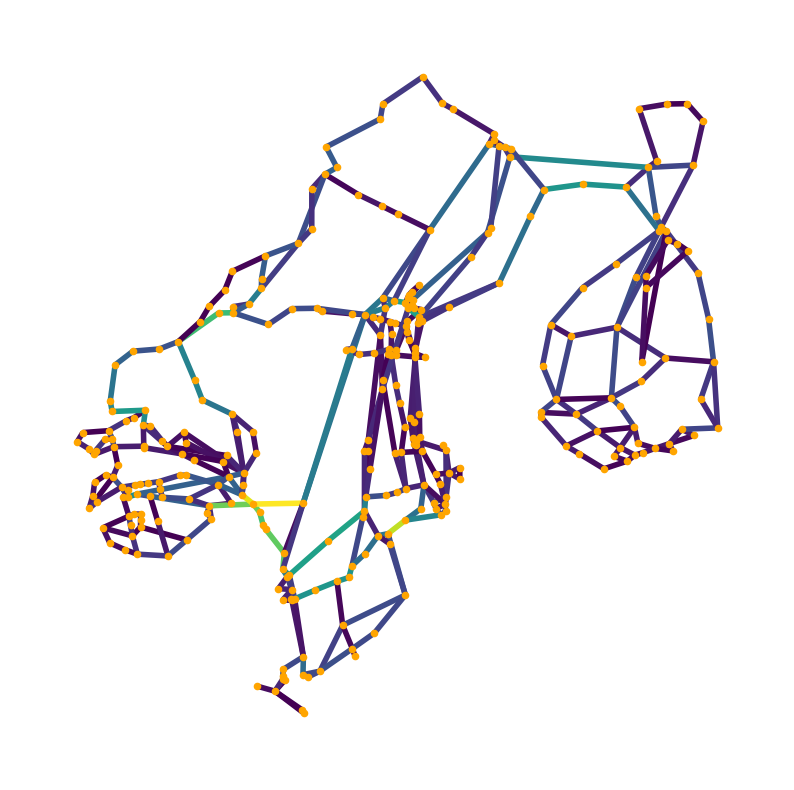Problem 4.4#
Note
This problem is mostly adapted from the following resources:
Integrated Energy Grids
Problem 4.4
Note
If you have not yet set up Python on your computer, you can execute this tutorial in your browser via Google Colab. Click on the rocket in the top right corner and launch “Colab”. If that doesn’t work download the .ipynb file and import it in Google Colab.
Then install the following packages by executing the following command in a Jupyter cell at the top of the notebook.
!pip install numpy networkx pandas matplotlib
a) Create a network object and calculate the average degree
We load the simplified dataset of the European high-voltage transmission network including nodes and edges and codify it in networkX.
In this dataset, HVDC links have been left out, and the data only shows AC transmission lines.
nodes = pd.read_csv('data/nodes.csv', index_col=0)
nodes.head(5)
| x | y | |
|---|---|---|
| Bus | ||
| 8838 | -2.169800 | 53.243852 |
| 7157 | 11.927347 | 45.403086 |
| 1316 | 14.475861 | 40.761821 |
| 7421 | 4.520127 | 50.488619 |
| 1317 | 14.639282 | 40.688969 |
edges = pd.read_csv('data/edges.csv', index_col=0)
edges.head(5)
| bus0 | bus1 | s_nom | x_pu | |
|---|---|---|---|---|
| Line | ||||
| 8968 | 1771 | 1774 | 491.556019 | 0.000256 |
| 11229 | 3792 | 3794 | 3396.205223 | 0.000017 |
| 11228 | 3793 | 3794 | 3396.205223 | 0.000012 |
| 11227 | 3793 | 3796 | 3396.205223 | 0.000031 |
| 8929 | 927 | 929 | 491.556019 | 0.000092 |
networkx provides a utility function nx.from_pandas_edgelist() to build a network from edges listed in a pandas.DataFrame:
N = nx.from_pandas_edgelist(edges, "bus0", "bus1", edge_attr=["x_pu", "s_nom"])
We can get some basic info about the graph:
print(N)
Graph with 3532 nodes and 5157 edges
degrees = [val for node, val in N.degree()]
np.mean(degrees)
np.float64(2.920158550396376)
b) Add the information on the position of each node provided in ‘data/nodes.csv’ and make a plot of the network
The nodes DataFrame provides us with the coordinates of the graph’s nodes. To make the nx.draw() function use these coordinates, we need to bring them into a particular format.
{nodeA: (x, y),
nodeB: (x, y),
nodeC: (x, y)}
pos = nodes.apply(tuple, axis=1).to_dict()
Let’s just look at the first 5 elements of the dictionary to check:
{k: pos[k] for k in list(pos.keys())[:5]}
{8838: (-2.16979999999999, 53.243852),
7157: (11.9273472385104, 45.403085502256),
1316: (14.475861, 40.761821),
7421: (4.52012724307074, 50.4886188621382),
1317: (14.639282, 40.688969)}
Now, we can draw the European transmission network:
fig, ax = plt.subplots(figsize=(10, 10))
nx.draw(N, pos=pos, node_size=0)
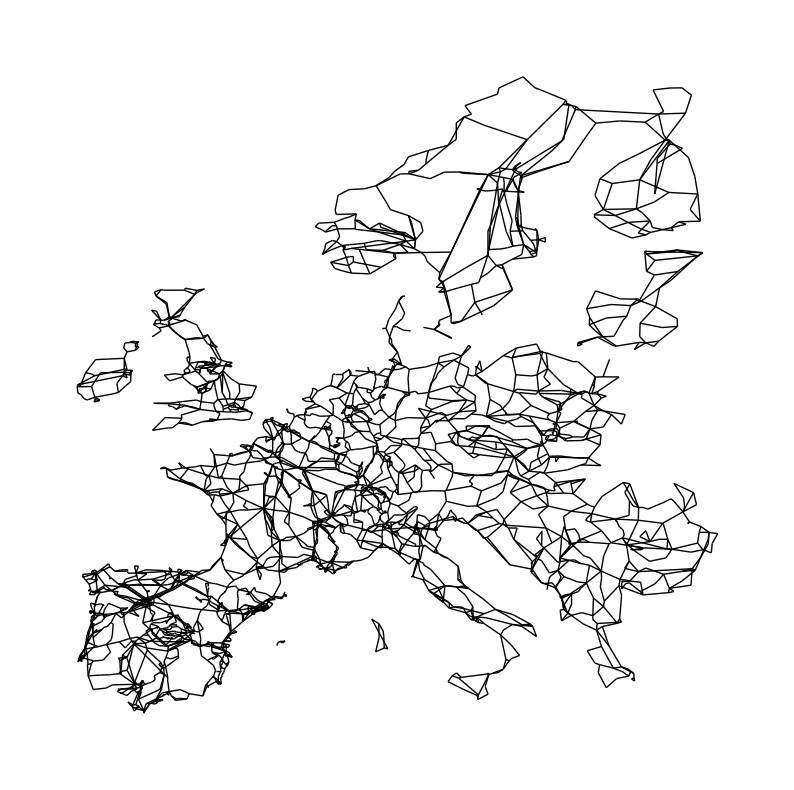
c) Determine how many independent network exists (these are the synchronous zones of the European transmission network)
You can already see that not all parts of the Network are connected with each other. Ireland, Great Britain, Scandinavia, the Baltics and some Islands in the Mediterranean are not connected to the continental grid. At least not via AC transmission lines. They are through HVDC links. These subgraphs denote the different synchronous zones of the European transmission network:
len(list(nx.connected_components(N)))
7
Let’s build subgraphs for the synchronous zones by iterating over the connected components:
subgraphs = []
for c in nx.connected_components(N):
subgraphs.append(N.subgraph(c).copy())
We can now color-code them in the network plot:
fig, ax = plt.subplots(figsize=(10, 10))
colors = ["red", "blue", "green", "orange", "teal", "cyan", "black"]
for i, sub in enumerate(subgraphs):
sub_pos = {k: v for k, v in pos.items() if k in sub.nodes}
nx.draw(sub, pos=sub_pos, node_size=0, edge_color=colors[i])
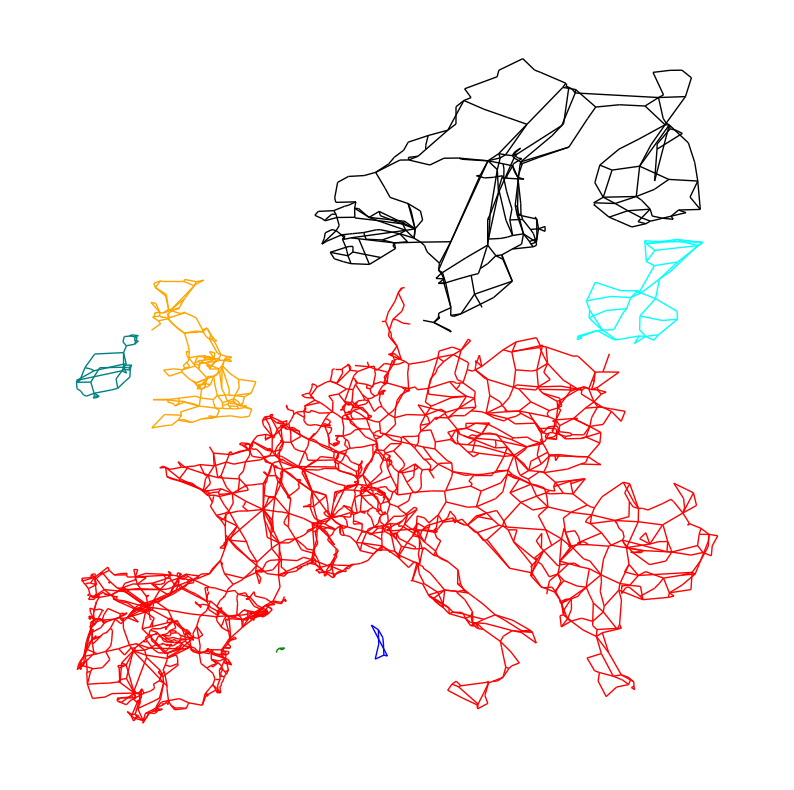
d) For the synchronous zone corresponding to Scandinavia, calculate the number of nodes and edges. Calculate the Adjacency, Incidence and Laplacian matrix.
SK = subgraphs[6]
Number of nodes and edges
len(SK.nodes)
304
len(SK.edges)
437
Adjacency matrix:
A = nx.adjacency_matrix(SK, weight=None).todense()
plt.imshow(A, cmap="Reds")
<matplotlib.image.AxesImage at 0x7f4fd43b6150>
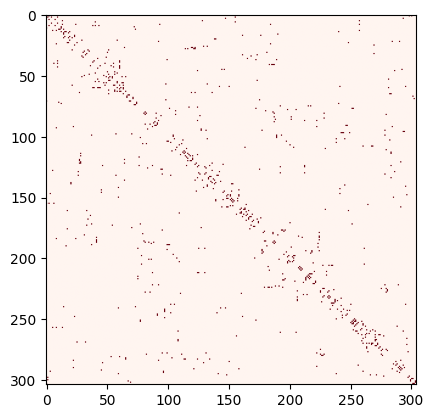
Incidence matrix:
K = nx.incidence_matrix(SK, oriented=True).todense()
K
array([[-1., -1., -1., ..., 0., 0., 0.],
[ 0., 0., 0., ..., 0., 0., 0.],
[ 0., 0., 0., ..., 0., 0., 0.],
...,
[ 0., 0., 0., ..., 1., -1., 0.],
[ 0., 0., 0., ..., 0., 0., -1.],
[ 1., 0., 0., ..., 0., 1., 1.]], shape=(304, 437))
plt.imshow(K, cmap="PRGn")
<matplotlib.image.AxesImage at 0x7f4fc29ec850>
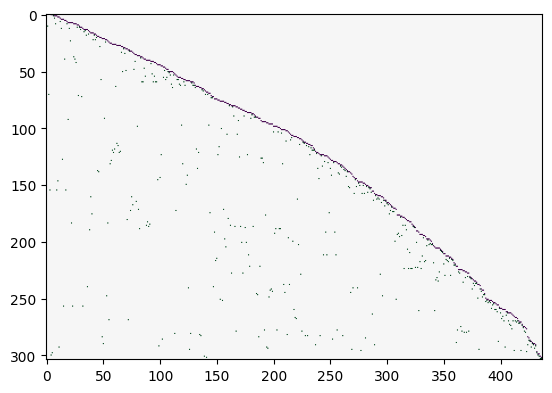
Unweighted Laplacian:
L = nx.laplacian_matrix(SK, weight=None).todense()
L
array([[ 4, 0, 0, ..., 0, 0, -1],
[ 0, 3, -1, ..., 0, 0, 0],
[ 0, -1, 4, ..., 0, 0, 0],
...,
[ 0, 0, 0, ..., 3, 0, -1],
[ 0, 0, 0, ..., 0, 2, -1],
[-1, 0, 0, ..., -1, -1, 3]], shape=(304, 304))
plt.imshow(L, cmap="viridis")
<matplotlib.image.AxesImage at 0x7f4fc1b37710>
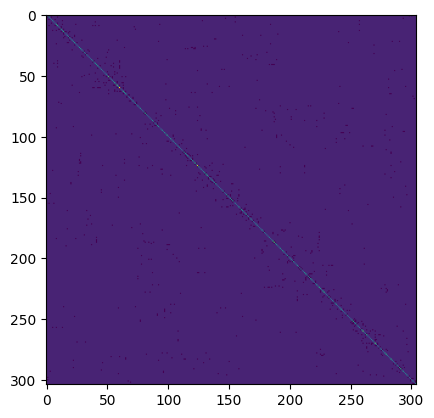
a) Add to the network object the information on the links susceptance, calculate the weighted Laplacian (or susceptance matrix), and the Power Transfer Distribution Factor (PTDF) matrix.
If we want to calculate the weighted Laplacian \(L = KBK^\top\), we also need the diagonal matrix \(B\) for the susceptances (i.e inverse of reactances; \(1/x_\ell\)):
x_pu = nx.get_edge_attributes(SK, "x_pu").values()
b = [1 / x for x in x_pu]
B = np.diag(b)
plt.imshow(B, cmap="Blues", vmax=30000)
<matplotlib.image.AxesImage at 0x7f4fc1b9ecd0>
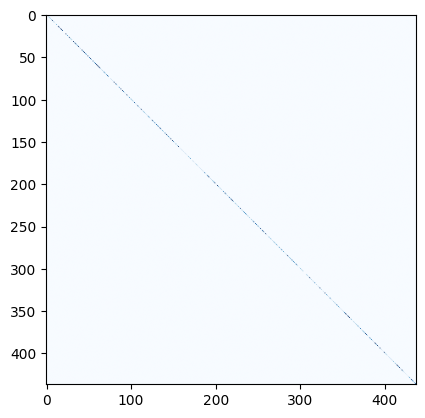
Now, we can calculate the weighted Laplacian as \(K_{il}\frac{1}{x_l}K_{lj}\)
L = K.dot(B.dot(K.T))
L
array([[ 36113.57986264, 0. , 0. , ...,
0. , 0. , -18151.34857397],
[ 0. , 31358.01814325, -10050.1263032 , ...,
0. , 0. , 0. ],
[ 0. , -10050.1263032 , 74308.06823101, ...,
0. , 0. , 0. ],
...,
[ 0. , 0. , 0. , ...,
25302.61955737, 0. , -16959.62285326],
[ 0. , 0. , 0. , ...,
0. , 35660.69258263, -25098.22536531],
[-18151.34857397, 0. , 0. , ...,
-16959.62285326, -25098.22536531, 60209.19679254]],
shape=(304, 304))
plt.imshow(L, cmap="RdBu")
<matplotlib.image.AxesImage at 0x7f4fc29b81d0>
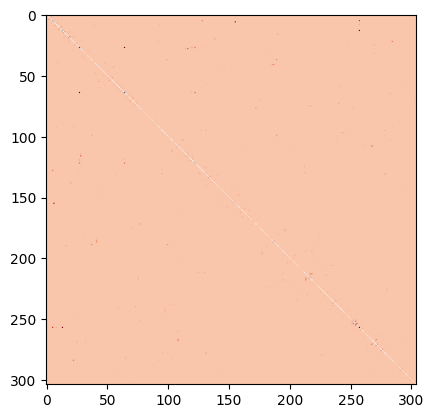
The PTDF matrix measures the sensitivity of power flows in each transmission line relative to incremental changes in nodal power injections or withdrawals throughout the electricity network.
The weighted Laplacian of the network is not invertible, but we can use the Moore Penrose pseudo-inverse
L_inv = np.linalg.pinv(L)
Now, we can calculate the PTDF matrix
PTDF = (B.dot(K.T)).dot(L_inv)
plt.imshow(PTDF, cmap="RdBu", vmin=-1, vmax=1)
<matplotlib.image.AxesImage at 0x7f4fc1a76cd0>
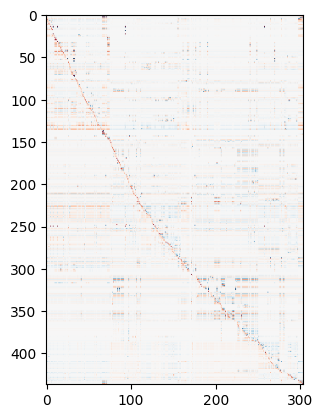
b) Assuming that power injection in the nodes increases linearly from -1 in the first node to +1 in the last node, calculate and plot the power flows in the network.
p_i = np.linspace(-1, 1, len(SK.nodes))
p_i[:10]
array([-1. , -0.99339934, -0.98679868, -0.98019802, -0.97359736,
-0.9669967 , -0.96039604, -0.95379538, -0.94719472, -0.94059406])
p_i.sum()
np.float64(0.0)
p_l = PTDF.dot(p_i)
p_l[:10]
array([ 2.80121239, 0. , -0.8157839 , -0.98462273, 0.19133233,
6.5928154 , -5.78994263, -2.46201253, -1.48532332, -0.85500233])
abs_p_l = np.abs(p_l)
fig, ax = plt.subplots(figsize=(10, 10))
nx.draw(SK,
with_labels=False,
ax=ax,
pos=pos,
node_color="orange",
node_size=20,
font_weight="bold",
edge_color=abs_p_l,
width=4)
